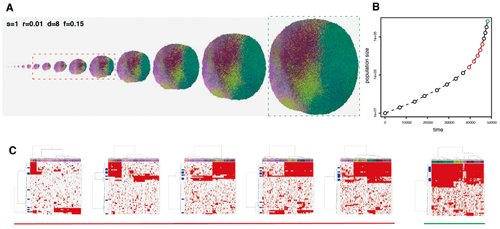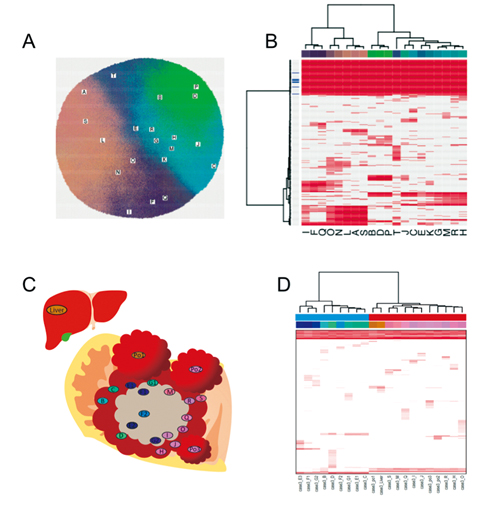Simulating cancer evolution to understand principles generating intratumor heterogeneity


Fig. 1:Visualized simulation of cancer evolution. (A) Growing cancer, (B) Growth curve, (C) Genetic mutation pattern

Fig. 2:Genetic mutation patterns with high heterogeneity obtained by simulation of cancer evolution (A, B) and genome analysis of colorectal cancer (C, D)
Cancer results when cells abnormally proliferate by genetic mutation. It is known that every patient has his or her own different cancer-causing genetic mutation. Furthermore, it has been revealed that even a single cancer in a patient has multiple cell populations with various combinations of genetic mutation. This phenomenon is called intratumor heterogeneity, and thought to play a role in resistance to anti-cancer therapy. Provided that a tumor consists of a large number of cell A which responds to treatment and small numbers of treatment-resistant cell B, the tumor temporarily shrinks with treatment due to the decrease of cell A. However, when cell B grows, before long, the tumor recurs. Therefore, it is a clinically important task to clarify the principles generating intratumor heterogeneity.
We first worked with Kyushu University Beppu Hospital to investigate the tumor heterogeneity of colorectal cancer. We took DNA samples from multiple sites of a single colorectal tumor and analyzed their genomes with the Next Generation Sequencer. As a result, we found a genetic mutation shared by all samples. Meanwhile, it was revealed that each sample has its own genetic mutation, which causes high heterogeneity.
Next, we tried to clarify the principle generating such intratumor heterogeneity, and constructed a simulation model of cancer evolution, the Branching Evolutionary Process (BEP) model. When cells are allowed to grow by mutating multiple genes randomly, cells accumulating driver mutations that increase proliferation rate are selected. As a result, they evolve into a cell population with high proliferating ability. In such an evolutionary process, the cells branch into cell populations with different mutations under a certain condition and acquire heterogeneity.
We simulated cancer evolution under various conditions with the K computer in an exhaustive search for a condition which generates high heterogeneity. We found that if we postulate a high gene mutation rate and the existence of cancer stem cells, we can reproduce the gene mutation pattern with high heterogeneity observed in the above experimental results using colorectal cancer. In addition, the results of our simulation suggested that driver genes are shared by all tumor cells, while most heterogeneity-producing mutations are neutral mutations which do not affect the cell growth rate.
As above, in our study, some evolutionary principles generating intratumor heterogeneity were elucidated by genome analysis of colorectal cancer and simulation of cancer evolution with the K computer. From now on, we plan to establish a treatment strategy based on a study to overcome treatment-resistant cancers.
ZOOM IN Theme3 Multi-scale simulation of platelet aggregation in initial stage of thrombogenesis


















